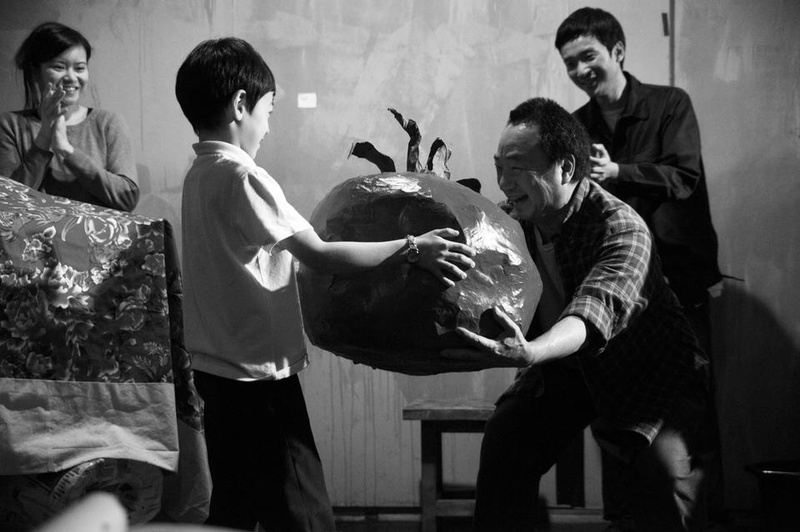
Katie Leug (left), Ron Nakahara (center), and Orion Lee (right), rehearse 'Wild Swans' in the ART in preparation for its premier
Adapting the 1993 British Book of the Year “Wild Swans” to fit both the American and British stage is no easy task. But the ambitious team behind the American Repertory Theater’s and London’s Young Vic Theater’s collaborative project “Wild Swans” succeeds for the most part in overcoming cultural boundaries. The play, adapted from Jung Chang’s book and directed by British director Sacha Wares, follows one family through three generations, highlighting the familial discord caused by Mao Ze Dong’s regime. Running at the Loeb Drama Center until March 11, “Wild Swans” provides an engaging insight into Chinese culture and brings the audience into close contact with the visceral and physical nature of the Chinese Revolution.
Playwright Alexandra Wood took Chang’s 500-page novel and condensed it into a 100-minute production. The play focuses mostly on the life of De-Hong (Ka-Ling Cheung), a politically radical young Chinese woman who marries a fellow Maoist revolutionary. As she becomes older, the regime she helped to establish turns against her and after the birth of her daughter (Katie Leung), De-Hong is forced to abandon the ideology she once fought so hard to preserve.
Family plays a central role in “Wild Swans,” though this fact was never properly communicated through the acting. The relationships between the family members are considerably weakened by the lack of chemistry between the principal actors onstage, especially with the father of the family, Shou-Yu (Orion Lee). Leung struggles to fully develop the believable relationship with Lee that the script requires. Scenes that ought to be gripping become lifeless. When Er-Hong leaves her father behind in the countryside so she can move to the city, she spends her last moments with him planting seeds in a field. What could be a touching scene that is important for the development of both characters feels like two colleagues ending a stressful day of manual labor together rather than the parting of father and daughter for an unknown amount of time.
The play’s lack of onstage chemistry stands in contrast to its innovative set, which provides “Wild Swans” with some of its most poignant moments. The set itself, designed by Miriam Beuther, shrinks the playing space of the normally expansive Loeb Mainstage. The actors perform in what looks like a living tapestry. The stage is limited by a very long, shallow box which narrows the performance space to near 2-dimensionality.
The restricting effect of this set design creates a sense of claustrophobia that runs through almost the whole production. At the end of the play, the stage opens up and the shallow set explodes into a maze of mirrors, cubes, and pathways that represent the family’s move from the country to the city. Finally the stage is used to its full capacity, but this sense of liberation only lasts a few short scenes.
The stage is partitioned into different segments, each one representing different locales as the play goes on. Wares provides detailed choreography for the scene transitions—which usually only function as placeholders in between the main points of the play—as a way of illuminating life in Maoist China for the audience. One of the most ambitious transitions involves the ensemble bringing bags of dirt onstage, spreading their contents across the stage to create a field. Moments such as this one provide a real sense of the strenuous labor that characterized a Chinese peasant’s life in the middle of the twentieth century. In order to shift from the field of dirt to a hospital wing, the same ensemble used traditional Chinese farming equipment to clear the stage. These transitions serve to show the cultural transition that China was undergoing during the 50’s, 60’s, and 70’s and informed the rest of the action onstage.
This group of performers brought the real tragedy of the story to life as their scenes show the impact the Cultural Revolution had on the entire country. For example, in one scene a group of students invades the house of the main characters during a protest attacking the supporters of Mao’s Cultural Revolution. It serves as a chilling reminder of the power that radical politics has over its subscribers, and the dangers of fanaticism generally. However, at times they were pushed to less believable extremes, such as a group of revolutionary youths being led in protest by an actor who feels more like a circus clown than a committed Maoist.
“Wild Swans” is, for the most part, a well-executed piece of foward-thinking theater. The cohesion of the onstage society Ware has created is commendable considering the number of people involved in the scene transitions. Despite its flawed acting the production manages to portray the brutality of the Maoist regime due to its physical intensity and technical ambitions.
—Staff writer Joshua R. McTaggart can be reached at jmctaggart@college.harvard.edu
Read more in Arts
'Medea' Actors Overcome Poor Direction












